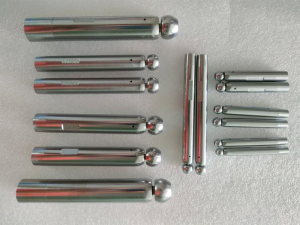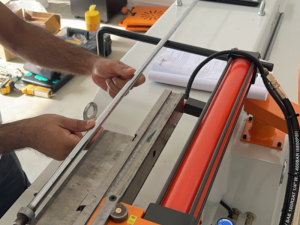One-stop Bending Solutions For Wires, Tubes And Pipes
One-stop Bending Solutions For Wires, Tubes And Pipes
In the realm of metalworking, the installation of the tube bending machine mold is a procedure of utmost significance. It directly impacts the quality and precision of tube bending, as well as the production efficiency and the service life of the equipment. Here, we will not only delve into the installation steps and key considerations for the tube bending machine mold in detail but also clarify the crucial role of the mold. Additionally, we will provide schematic diagrams of the mold and the bending process to assist you in better understanding and mastering this technique.
Due to the increasingly high requirements of industrial technology, the deformation and fullness of pipes are also getting higher and higher. From the original sand-filled pipe bending in the past to today’s mandrel bending, they are all in pursuit of the fullness of pipe bending. Gradually, there are several kinds of mandrels.
 |
 |
Ordinary mandrel:
1.When the CNC pipe bending machine bends pipes with a diameter of 6 or 8 millimeters, due to the small diameter and relatively large self-supporting force, the mandrel can be omitted and the ovality at the bending point can be guaranteed to be within 5% of the blind diameter. When the pipe diameter increases, in order to prevent the ovality of the bent pipe from increasing, a mandrel should be used.
2.When the pipe is pulled forward, due to the action of the mandrel, the material on the outside of the pipe center-line will be supported at the tangent point, generating tension and hardening to ensure its shape and not be flattened.
3.The position of the mandrel should be at the bending point, and the position of the tangent point affects the roundness of the pipe and the spring back of the pipe.
If the mandrel is too far forward, it is easy to stretch and deform the material on the outside of the pipe center-line, increase the length, thus reducing the spring-back and having a small ovality, but there is a goose-head phenomenon; sometimes ripples are also accompanied. If the mandrel is too far backward, the material on the outside of the pipe center-line does not have enough tension, causing the pipe to collapse, increasing the ovality and even wrinkles on the inside. Therefore, when the bending radius increases, the mandrel should be appropriately moved forward.
4.The mandrel should have an advance amount (passing the tangent point). There are many factors affecting it, such as the size of the front R of the mandrel, the size of the bending radius, the gap between the pipe inner diameter and the mandrel, and so on. The appropriate position of the mandrel should first be roughly estimated according to pipe bending experience, and then adjusted through tests to make it in the appropriate position and ensure that the pipe has no wrinkles, a small goose head, and an ovality within 5% of the pipe outer diameter.
5.In order to avoid ripples on the material on the outside of the pipe center-line, in addition to correctly designing and adjusting the mandrel, the mandrel rod should have sufficient rigidity to avoid ripples caused by trembling and use appropriate lubricants. In order to avoid scratches on the inner wall of the pipe, the mandrel should have sufficient rigidity and be carefully deburred and polished; the inner cavity of the pipe should also be carefully cleaned and wet blasting is necessary if necessary.
6.The radial gap between the mandrel and the pipe inner diameter should not be greater than 0.15 millimeters. If the gap is too large, wrinkles may occur even if the mandrel is adjusted forward.
7.Due to the large wall thickness tolerance of the pipe, in order to ensure the gap, the mandrels should be grouped and selected according to the pipe inner diameter.
When using the mandrel, although the material on the outside of the pipe center-line is thinned due to tension, the reduction in thickness should not exceed 10% of the wall thickness. Mild wrinkles are allowed, but not more than 25% of the wall thickness.
Ball mandrel:
In the case of bending thin-walled, large-diameter and small bending radius pipes, a ball mandrel should be used. The ball of the ball mandrel can swing in any direction. Like using an ordinary mandrel, the function of the ball mandrel is to keep the pipe still supported around the pipe after leaving the mandrel so that the pipe does not collapse. The adjustment of the ball mandrel is the same as that of an ordinary mandrel. The difference is that the spherical part should be placed in the front, and the straight rod part at the back is adjusted according to the ordinary mandrel.
Adjustment of boost:
During bending, the boost is used to push the pressure die to actively move longitudinally to counteract the resistance that appears during bending. This is a characteristic of machine bending.
Using boost can prevent excessive thinning of the pipe wall during bending, reduce pipe spring-back, and at the same time counteract resistance, push the pipe to complete bending, and reduce the burden on the clamping die, which is beneficial for bending. Generally speaking, using boost can reduce the clamping length and the minimum bending radius.
The speed of the boost can be adjusted by the speed control valve installed on the booster cylinder. It should be adjusted to be slightly faster than the bending speed to obtain a certain lateral thrust.
The small mandrel really has great power. The addition of mandrels has advantages and disadvantages, and it should be adopted according to the actual situation.
If you have the need for pipe machining requirements, ANTISHICNC DW50CNC-2A-1S CNC pipe bending machine can be a reference for you.

The mandrel mechanism of the DW50CNC-2A-1S pipe bending machine is located at the rear of the machine bed. The required bending radius of the mandrel can be adjusted through screw drive. The movement of the mandrel is realized by the mandrel and the oil cylinder. The lead amount of the mandrel can be adjusted by adjusting the nut. A mandrel support device is installed on the machine bed to support the mandrel and pipe fittings. If core-less bending is performed, the mandrel will be removed.
| Name | DW50CNC-2A-1S |
| Max bending capacity 1.5D carbon steel | Φ50.8×2.5mm |
| Max bending capacity 1.5D stainless steel | Φ45×2mm |
| Max feeding stroke (b) | 2500mm (standard); can be customized to lengthen |
| Max core threading stroke | 3500mm (standard); can be customized to lengthen |
| Feeding method | Direct delivery or sandwich delivery |
| Max bending radius | R200mm |
| Max bending angle | 190° |
| The number of bent pipes that can be set for each pipe fitting | 16 pieces (PLC type)/33 pieces |
| The number of bend files can be set | 300 |
| Bending speed | MAX140 degrees/second |
| Tube rotation speed | MAX180 degrees/second |
| Feeding speed | MAX1000mm/sec |
| Bend angle | ±0.15 degrees |
| Turning tube angle | ±0.1 degrees |
| Feeding length | ±0.1 degrees |
| Rotary tube servo motor | 0.75KW |
| Feeding servo motor | 1KW |
| Oil pump motor | 5.5KW |
| Machine dimensions | ≈5000 X 950 X 1300 mm |
If you need a pipe bending machine, welcome to consult Shanghai ANTISHICNC. We have rich experience in manufacturing and and application of pipe bending machine, and can provide you with professional technical support.
Our equipment has CE, ISO quality inspection certificate, so the quality is guaranteed to be cost-effective. According to different processing requirements, machines can be customized to fit for your usage, to provide customized services. In the processing period, we strictly control the production process, to ensure the quality of clearance, standardize the process, strict implementation.
